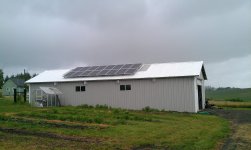... Lets says we would use 3KW per hour or a total of 15 KWH during that power generation time. We would have to install about 3.75 KW of panels on the roof to get 3KW at the outlets. The extra PV is for power loss in the system.
...
I was writing in a hurry and left out some information.
There is power loss from the generation of the DC power by the PV when converted to AC and other parts of the system. The calculator we used in class assumed an efficiency of around 75%. Meaning you would loose 25% of the power generated on the roof by the time it got to the outlets for use. Another way to look at this inefficiency is that it increases your cost by 25%. This is a little detail that can bite you. One might figure you need 40 KWH a day to cover one's power usage. Now one would assume you get power production sometime after sunrise until sometime before sunset. Nope. In my location, I get five hours of power producing light year round. This is another detail that is important. So if I need 40 KWH a day, I need to put 8 KW of panels on the roof, 40 KWH / 5 sunlight hours equals 8. Nope, that won't work because we will only get roughly 75% of the power from the panels to the outlets, so I REALLY need 8*1.25 or 10 KWH.... This just pushed up the cost.
But, the panels will loose efficiency over time so the design should include some extra generation to cover that loss. How much? Another 10-20% sounds good to me. So lets split the difference and say another 15% which means 11.5 KWH. The final KWHs is going to depend on the area you have for the PV installation as well as the best bang for the buck on the PV panel. Panels come in different power densities and costs so one has to balance the area for the installation with the PV size, and cost. In any case, this pushed up the cost again.
But, this really does not work either because my power usage is spread over 24 hours a day and I am producing power over five hours. So now you have to grid tie and/or have batteries. In NC, it does not appear to make money sense to grid tie AND produce 100% of your power unless you grid tie AND store your five hours of production in batteries. The grid tie would be to provide power when you have exhausted your batteries. One would not want to sell power back to the grid in NC under the current regulations.
BUT, batteries cost mucho money and have a limited lifetime. PV panels seem like they will last many decades. Frankly, I would be shocked if they did not produce a good part of the rated power for the rest of my life. Batteries are a different story. They add cost to the system but I don't see that they make money sense every time I look at the numbers. A problem with batteries is that they don't like temperature extremes so they should be in the house or other AC environment. I personally do not have space for them in the house so we are SOL.
People need batteries because batteries are required to provide backup power when there is a power outage. People are shocked when the find out that a grid tied system is not usable during a power outage.
But wait, storing power is going to loose a bit of power so you need to add more PV to the roof to make up for the loss which will require more battery storage. The system ends up being a bit larger than would initially expect and the price increases accordingly due to these power loses.
These issues are not show stoppers but they are buried in the details and not readily apparent but they do increase the system cost. Grid tie regulations change and can really determine what one does or does not do with a PV installation.
Later,
Dan
